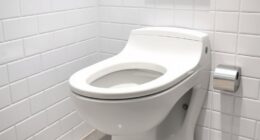Are you tired of dealing with clogged toilets and the hassle of using a plunger? Well, fear not! In this informative guide, we will show you how to unclog a toilet without a plunger.
Think of it as unlocking the secret to a smoothly flowing toilet, like opening a door to a world of uninterrupted flushes. With a few simple techniques and household items, you’ll be able to tackle those stubborn clogs with ease.
So let’s dive in and learn the art of plunger-free toilet unclogging!
Key Takeaways
- Flushing excessive toilet paper or non-flushable items down the toilet can cause clogs.
- Homemade drain cleaners like baking soda and vinegar or hot water and salt can effectively dissolve clogs.
- The plunger-free method using hot water and dish soap can also be used to unclog toilets.
- Regular maintenance and avoiding flushing non-flushable items can prevent clogs.
Understanding the Common Causes of Toilet Clogs
Understanding the common causes of toilet clogs can help you prevent future plumbing issues. There are several factors that contribute to clogs in toilets.
One of the main causes is flushing excessive toilet paper or other non-flushable items down the toilet. These items can accumulate and block the pipes, causing backups and clogs.
Another common cause is the buildup of mineral deposits, especially in areas with hard water. These deposits can restrict the flow of water and lead to clogs.
Additionally, using too much toilet paper in one flush can overwhelm the plumbing system and result in clogs. To prevent these issues, it is important to only flush toilet paper and waste, and avoid flushing items like wipes, feminine hygiene products, or excessive amounts of toilet paper.
With a good understanding of the causes of clogs, you can now move on to learning about using a homemade drain cleaner.
Using a Homemade Drain Cleaner
To clear the blockage in your toilet, try using a homemade drain cleaner. Here are some natural remedies for unclogging toilets that you can easily make at home:
-
Baking Soda and Vinegar: Mix 1 cup of baking soda and 1 cup of vinegar in a bowl. Pour the mixture into the toilet bowl and let it sit for about 30 minutes. Then, flush the toilet to see if the clog has cleared.
-
Hot Water and Salt: Boil a pot of water and add a few tablespoons of salt. Pour the hot water into the toilet bowl and let it sit for a few minutes. The combination of hot water and salt can help dissolve the clog.
-
Coca-Cola: Pour a can of Coca-Cola into the toilet bowl and let it sit for an hour. The acid in the soda can break down the clog.
Using these homemade drain cleaner alternatives can be a cost-effective and environmentally friendly way to tackle toilet clogs.
However, if these methods don’t work, you can try the plunger-free method: hot water and dish soap.
The Plunger-Free Method: Hot Water and Dish Soap
If you’re looking for an alternative method to clear a clog in your toilet, try using the plunger-free method of hot water and dish soap.
This technique is a hot water alternative that can be effective in breaking up the clog and allowing it to flow down the drain.
To start, fill a bucket with hot water, but not boiling, and add a few squirts of dish soap.
The heat and the soap will work together to break down the clog and lubricate the pipes.
Carefully pour the mixture into the toilet bowl and let it sit for a few minutes.
Then, flush the toilet to see if the clog has cleared.
If not, you can move on to the next method, the baking soda and vinegar solution, which will provide additional power to unclog your toilet.
The Baking Soda and Vinegar Solution
When it comes to unclogging a toilet, the efficiency of the chemical reaction is crucial.
The baking soda and vinegar solution offers a highly effective method to break down the clog and restore normal flow.
Not only is this solution cost-effective, utilizing common household items, but it also provides an alternative to traditional methods such as plunging.
Efficiency of Chemical Reaction
You can increase the efficiency of the chemical reaction by using hot water instead of cold water. Hot water helps to dissolve the chemical solution more effectively, allowing it to react faster and unclog the toilet quicker. Here are three reasons why using hot water is more efficient:
-
Increased solubility: Hot water has a higher solubility, meaning it can dissolve more of the chemical solution. This allows the solution to spread more evenly and penetrate the clog more effectively.
-
Faster reaction rate: Heat increases the rate of chemical reactions. By using hot water, you can speed up the reaction between the chemical solution and the clog, resulting in a quicker unclogging process.
-
Cost effectiveness: Hot water is readily available and does not require any additional cost. Using hot water to increase the efficiency of the chemical reaction is a cost-effective solution for unclogging your toilet.
Remember to always follow safety precautions when using chemical solutions. Wear protective gloves and goggles, and avoid mixing different chemicals together to prevent harmful reactions.
Cost-Effectiveness of Household Items
Now that you understand the efficiency of chemical reactions in unclogging toilets, let’s explore the cost-effectiveness of household items in preventing toilet clogs.
It’s important to take proactive measures to avoid clogs, as they can be a hassle and costly to fix. Luckily, there are several cost-effective drain cleaning solutions available.
Firstly, consider using a drain snake or auger, which are affordable tools designed to break up clogs. These can be easily inserted into the toilet drain and maneuvered to remove any obstructions.
Another inexpensive option is using a mixture of baking soda and vinegar. Simply pour a cup of baking soda into the toilet bowl, followed by a cup of vinegar. Let it sit for a few minutes before flushing with hot water. This combination creates a fizzy reaction that can help dissolve minor clogs.
Lastly, regular maintenance is key. Avoid flushing excessive toilet paper or non-flushable items down the toilet. Additionally, using a drain strainer in the bathroom can prevent hair and other debris from entering the drain.
Alternative to Traditional Methods
To prevent toilet clogs, consider using an eco-friendly drain cleaner made from natural ingredients. Not only will this alternative solution effectively unclog your toilet, but it will also help protect the environment.
Here are three reasons why eco-friendly options are a great choice:
-
Gentle yet powerful: Eco-friendly drain cleaners use natural enzymes and bacteria to break down clogs without harsh chemicals. This means they are safe for your pipes and won’t cause any damage.
-
Environmentally friendly: Traditional drain cleaners often contain harmful chemicals that can pollute water sources and harm aquatic life. By choosing eco-friendly options, you’re taking a step towards a cleaner and healthier planet.
-
Sustainable and cost-effective: Many eco-friendly drain cleaners are made from renewable resources and come in recyclable packaging. Not only are you helping the environment, but you’re also saving money in the long run.
Unclogging With a Toilet Brush or Wire Hanger
If you’re dealing with a clogged toilet and don’t have a plunger on hand, there are alternative unclogging methods you can try using common household items.
These methods can be effective in dislodging the clog and restoring proper flow.
Alternative Unclogging Methods
You can try using a mixture of baking soda and vinegar to unclog your toilet without a plunger. This method is not only cost-effective but also eco-friendly, making it a great alternative for those looking for sustainable solutions.
Here’s how to do it:
-
Start by pouring one cup of baking soda into the toilet bowl. Make sure to distribute it evenly around the bowl.
-
Next, pour one cup of vinegar into the bowl. The combination of baking soda and vinegar will create a chemical reaction that can help break down the clog.
-
Let the mixture sit in the bowl for about 30 minutes. During this time, the fizzing action will help loosen the clog.
After 30 minutes, flush the toilet to see if the clog has been cleared. If not, you may need to repeat the process or consider trying another method. Remember to always exercise caution when attempting to unclog a toilet and consider calling a professional if the clog persists.
Using Common Household Items
Using a mixture of baking soda and vinegar is a cost-effective and eco-friendly method to clear a clog in the toilet. It is one of the most popular cost-saving solutions and eco-friendly alternatives for unclogging a toilet without a plunger.
To begin, pour one cup of baking soda into the toilet bowl. Make sure it covers the entire area of the clog. Next, pour one cup of vinegar over the baking soda. The mixture will create a fizzing reaction, which helps break down the clog.
Let it sit for about 30 minutes to an hour. Finally, flush the toilet and check if the clog has cleared.
This method is not only effective but also safe for your plumbing system and the environment.
Getting Rid of Stubborn Toilet Blockages With a Plumbing Snake
To tackle stubborn toilet blockages, grab a plumbing snake and carefully insert it into the toilet bowl. Follow these steps to effectively use a plumbing snake:
-
Insert the snake: Gently push the snake into the drain, ensuring it goes in as far as possible without forcing it.
-
Rotate and push: Slowly rotate the handle of the snake while pushing it further into the drain. This motion helps break up the clog and clear the blockage.
-
Retrieve the snake: Once you feel the resistance lessen, slowly pull the snake out of the drain. Be cautious not to damage the toilet bowl or pipes.
If you don’t have a plumbing snake or prefer alternative methods, you can consider using a wire coat hanger or a wet/dry vacuum to tackle the clog. However, for more severe clogs or if you’re unsure about unclogging techniques, it’s best to seek professional unclogging services.
Preventive Measures to Avoid Future Toilet Clogs
By following these preventive measures, you can reduce the likelihood of future toilet clogs.
Regular preventive maintenance is key to keeping your toilet in good working condition.
First, be mindful of what you flush down the toilet. Avoid flushing items like paper towels, wipes, or feminine hygiene products, as these can easily cause blockages. Additionally, consider using a toilet paper that is designed to dissolve quickly in water.
Another preventive measure is to avoid overloading the toilet bowl. Flush multiple times if necessary, instead of trying to flush everything in one go.
Lastly, consider scheduling professional plumbing services on a regular basis. A professional plumber can inspect your toilet system, identify any potential issues, and take preventive measures to ensure everything is functioning properly.
Taking these steps will help you avoid costly and inconvenient toilet clogs in the future.
Conclusion
In conclusion, unclogging a toilet without a plunger is possible with the right techniques and tools.
By understanding the common causes of toilet clogs and using homemade drain cleaners like hot water and dish soap or the baking soda and vinegar solution, you can effectively clear the blockage.
If these methods don’t work, using a toilet brush or wire hanger can help, and for stubborn clogs, a plumbing snake is your best bet.
Remember, taking preventive measures such as proper flushing and avoiding flushing non-flushable items can significantly reduce future toilet clogs.
Did you know that an average household can experience up to 3 toilet clogs per year? That’s nearly 225 million clogs across the United States annually, causing inconvenience and frustration.
So, it’s important to know these plunger-free methods to save time and effort.










